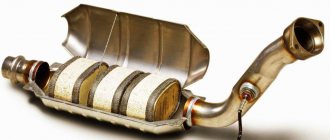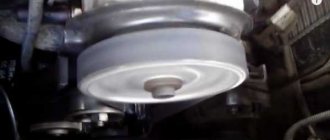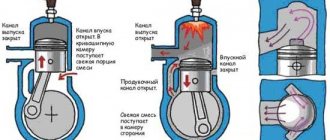A catalytic converter (popularly just a catalyst) is an element of a car exhaust system designed to reduce the toxicity of combustion products of the air-fuel mixture. Partially dampens the exhaust sound due to heat extraction. It is controlled by one or two oxygen sensors (lambda probes), based on signals from which the ECU (electronic control unit) adjusts the proportions of the air-fuel mixture. In general, it does not affect anything other than an attempt to preserve the ecology on planet Earth.
Removing a catalyst is an illegal intervention in the design of a car's exhaust system, which consists of cutting out the element completely, or knocking out its filling. This is done for several reasons, but the result is always the same - the car emits exhaust gases into the atmosphere without any reduction in toxicity. It is also believed that removing the catalyst can reduce fuel and engine oil consumption, and also increase engine power...
The article was written in such a way that the author, on many points, almost directly discourages removing the catalyst without installing a new one. In fact, the purpose of the material is not to convince anyone of anything. The purpose of the article is to collect in one place as much unbiased and understandable information as possible, on the basis of which the reader could draw the most objective conclusions and broaden his horizons.
Have you already removed the catalyst?
View more auto polls later
Why is the catalytic converter removed?
There are several reasons to remove the catalytic converter:
and the main one is the high cost of replacement
Very rarely, when removing a catalyst, the goal is to increase engine power or reduce fuel consumption. Nobody remembers this element of the car exhaust system at all as long as it works properly. However, like any other car part, the catalytic converter is far from eternal.
He works in extremely harsh conditions. Literally, on the front line. Receives exhaust gases directly from the exhaust manifold. But here they are hot, dense and moving quickly. Accordingly, over time, the catalyst fails - it becomes clogged, melts or even crumbles. As a result, the throughput of the exhaust system decreases and the engine, as they say, suffocates itself.
This is the most common reason for removing a catalytic converter. Approximately 25% of domestic motorists buy and install a new one. The rest cut out the worn-out one and try to work around new problems that have arisen using various folk methods. But we'll talk about them later.
Why can’t you just go ahead and replace the failed catalyst? It's simple. This part is not cheap. If you buy a new neutralizer in its original design, then even for the simplest car it can cost 10 - 30 thousand rubles. In this case, resorting to searching for a used catalyst is inappropriate. The same as buying a cheap fake of the original.
It is clear that such expenses for many domestic motorists are considerable, if not unaffordable. Especially when you consider that replacing a clogged catalyst will not bring any tangible benefit to the car owner personally. As they say, this detail does not affect the speed. Only for the environment...
To be fair, this is not the only purpose of catalyst removal. There are times when service stations (of course, not dealerships) insist on this, promising a significant increase in power, throttle response and, of course, a reduction in fuel consumption by almost one and a half to two times. There are also those who, after reading a couple of articles on the Internet, came to the hasty conclusion that removing the catalyst is an excellent and cheap form of tuning.
Be that as it may, most often the catalyst is removed without replacement for the same reason - the old one is clogged (crumbled, melted), and a new original one costs at least two or three full tanks of gasoline. So it turns out that 75% of cars with a mileage of more than a hundred thousand kilometers on domestic roads drive without catalysts.
What to do?
First, I will say one thing, an increase in consumption appears only among those who installed a decoy on the second “LAMBDA”. Here the firmware remains standard, factory, like both oxygen sensors, we just deceive the second one using a special insert. Namely, it is through the first DC that the flow of gases increases.
So how to solve the problem. There are only three main ways:
- Install a universal catalyst . As I wrote above, many people will like this method (here, as they say, environmentalists are happy - we don’t pollute the atmosphere, it’s good for you - it costs a little more than a flame arrester, and those around you are happy - the car doesn’t stink like a “six”). It will create back pressure in the pipe, and thus the amount of oxygen passing near the first DC will decrease; as a rule, the flow rate will return to normal. It is worth noting that it also needs to be calculated correctly, it is available for certain engine sizes, it can be welded into the line under the car (and not into the “cat collector”), so that even if it collapses, it will not reach the engine. By the way, the price of a universal neutralizer for an ordinary foreign car is about 5,000 – 7,000 rubles, wouldn’t you agree? It’s inexpensive?
- Install a flame arrester . It will also increase the back pressure in the pipe, because often the flame arrester has a smaller internal diameter and chambers that “extinguish” the pressure. As a rule, after installation, the flow rate is normalized
Catalyst life
Such a catalyst is of no use - it needs to be replaced or removed
The service life of the catalyst varies from a couple of hundred to 150 thousand kilometers. This mileage depends on many factors:
- original spare part or fake;
- fuel quality;
- octane number of gasoline;
- timely replacement of the air filter;
- driving style;
- technical condition of the engine;
- dustiness of the environment;
- average temperature in the region;
- condition of roads (deep holes, sprinkling with reagents, etc.).
Under ideal conditions, the catalytic converter is fully capable of working 100 - 150 thousand kilometers. After this, problems will begin. Including, the power and throttle response of the engine will decrease, fuel consumption will gradually increase, idle speed may fluctuate, and so on. When the catalyst is completely damaged, the car will have difficulty starting, may stall while driving, or its operation will become completely impossible.
By the way, although few people are interested in this, the reduction in exhaust gas toxicity also worsens over time. The active surface of the catalyst filling decreases, and more and more compounds have a detrimental effect on it. A completely clogged catalyst does not help in the fight for the notorious environment at all.
Is it bad when this element fails?
From what was said earlier, it becomes clear that the catalyst is an element necessary to improve the environmental characteristics of the car.
But if it doesn’t exist, then the technical characteristics, including power and fuel consumption, will, on the contrary, begin to improve. The engine itself does not care whether there is a catalyst in the exhaust system or not. This is necessary so that the car meets environmental standards, does not pollute the environment, and can be driven in countries where environmental standards are the highest. EU countries can easily be included among them. Russia also has environmental rules, but they are somewhat less stringent.
So if you cut it out, what will change in the car? Almost nothing.
But here it’s fair to ask why the Check light comes on on the car and problems arise in the operation of the internal combustion engine.
When the catalyst melts or becomes clogged, the gas can no longer easily pass through it. Because of this, part of the gas that has already left the engine begins to return back and enters the combustion chamber.
Literally speaking, the engine begins to choke itself.
But when you checked the catalyst for cloggedness, and it turned out that everything was fine with it, you can assume a different scenario as to why the check engine light is on. This is often due to trivial mileage and natural wear and tear. Modern cars have lambda probes, that is, oxygen sensors. One is before the catalyst, the second after. They give a signal about the operation of the unit and check the degree of purity of the gas. If the level of harmful emissions increases, then the probe gives a signal about the failure of the catalyst or a decrease in its performance.
Here you will need to change the neutralizer.
On some cars, the car may not start, or it may start and stall if the catalyst does not work.
You also need to be prepared for this.
Signs of a dead catalyst
A working catalyst must be completely translucent
There are several indirect signs indicating partial or complete wear of the catalytic converter:
- the level of carbon monoxide in the exhaust gases has increased (but this must be measured);
- the engine power has decreased (it’s also hard to tell by eye);
- fuel consumption has increased;
- idle speed began to “float”;
- exhaust gases have a sharper and more noticeable odor;
- the noise level of the exhaust system has increased;
- visible smoke began to appear;
- The Check Engine light is on on the dashboard;
- the catalyst lasted more than 100 thousand kilometers.
It is worth noting that practically none of these signs alone allows one to accurately establish the fact of serious wear of the catalyst. The most obvious and guaranteed way to verify this is barbaric disassembly using an angle grinder. Also, in some advanced cases, wear can be seen if you simply remove the catalyst. It is either not transparent (clogged tightly or melted), or its filling spills out (shattering).
The catalytic converter is knocked out, is this bad for the car?
As I wrote above, this is simply an environmental system, and if it is not there, then the car, on the contrary, will improve its characteristics (power, consumption). To put it simply, the engine doesn’t care about this converter, whether it is there or not.
But why on many cars, if this unit fails (say, melted, clogged or crumbled), the CHECK ENGINE and the car begins to behave abnormally, traction disappears, sometimes it trots a little, and simply may not start at all.
And here, friends, everything is simple. If the catalyst is melted or clogged, then the exhaust gases cannot pass through it normally, which means that some returns back into the combustion chamber and makes the newly introduced combustible mixture less efficient. The motor is choking itself.
If there is no melting, but the “CHECK” light comes on, then perhaps it has simply worn out due to high mileage. In modern cars there are so-called oxygen sensors (lambda umbrellas), one is located in front of the catalyst, the other after and detects the presence of harmful compounds; if their percentage has increased, then the second (or also called the lower “lambda”) gives a signal that the converter is not working ( or it doesn’t do its job as it should) AND IT NEEDS TO BE REPLACED. By the way, some cars may not even start (a tribute to the environment).
Thus, by knocking out or removing it, you simply free the car’s exhaust tract from the obstacle in the form of a filter and lower its environmental standards. BUT AGAIN - THIS DOES NOT AFFECT THE RESOURCE OF THE POWER UNIT !
BUT in order for your car to drive normally, you need to upgrade to a lower environmental class (usually EURO2) or install a fake one. Otherwise, the program in the ECU will not allow you to drive normally.
Removing the catalyst and saving on buying a new one
The catalyst is located in this place
If we talk honestly about the pros and cons of removing the catalyst, then this point is the only adequate advantage (and at the same time, an excuse). As mentioned above, the original part costs relatively a lot of money. And given the uselessness of the catalyst in terms of the dynamic characteristics of the car, its replacement naturally raises doubts among many.
Of course, simply removing the catalyst without other actions (and expenses) will not work. At a minimum, you will have to insert a flame arrester in its place. And you will also need to somehow “deceive” the ECU so that it “doesn’t notice” the loss. And the procedure itself, if you do not dare to do it yourself, costs money. In general, expenses cannot be avoided. Although, of course, it is possible to reduce them.
How to normalize consumption after cutting out a cart?
The easiest way to reduce gasoline and oil consumption is to install the catalytic converter back. If purchasing a new part is not part of your plans due to the high cost, you can consider the option of a repair or universal autocat.
The second option is to properly perform tuning after removal. Contact a service to measure the pressure in the outlet assembly, install a flame arrester with the correct outlet and outlet opening to ensure the correct back pressure. Correct the oxygen sensor data using fakes or flash the ECU.
Catalyst removal and fuel consumption
After removing the catalyst, the flow rate may decrease, increase,
and also remain at the same level
On this point, who says what? Some argue that the consumption does not change at all after removing the catalyst. Others note with sadness that the car began to take even more fuel than before. Naturally, there are those who talk about reducing consumption, citing different indicators. For some it is 3%, but for those who are more interested in convincing you to remove the catalyst, they promise up to 30% savings on fuel.
In fact, the situation with fuel consumption after removing the catalytic converter is not always clear-cut. If you reduce all similar factors, you can leave only three possible outcomes:
- Fuel consumption will increase . This occurs in cases where the catalyst is removed without any manipulation of the oxygen sensors or ECU firmware. The latter “detects” the loss and begins to strictly adjust the composition of the air-fuel mixture. As a result, the car stops driving normally, and consumption increases.
- Fuel consumption will not change . Such “success” awaits those who, after removing the catalyst, installed a new spare part, or successfully “deceived” the ECU by slipping it adapted firmware or dummy oxygen sensors (so-called decoys).
- Fuel consumption will decrease . For this to happen, many conditions are needed. Firstly, the catalyst to be removed must be completely killed. Secondly, the cutting was done competently, taking into account the “needs” of the ECU. Thirdly, if consumption decreases, it will not be by much.
In any case, the flow rate after removing the catalyst will not decrease in any way more than to the nominal value. And even then, it’s unlikely. As practice shows, if in reality it is possible to achieve some kind of reduction in consumption, then perhaps by a measly couple or three percent. You can save much more if you read how to change gears on a manual transmission, how to drive an automatic transmission, or about the reasons for increased fuel consumption.
Well, in conclusion, regarding fuel consumption after removing the catalyst, I would like to say a few words about my colleague’s opinion. Yes, if you remove a clogged catalyst from the exhaust gas path, the resistance will theoretically decrease. This means that fuel consumption must be reduced. However. Almost no one leaves the space of the removed catalyst empty. At a minimum, a flame arrester is installed in this part of the exhaust system, which again creates resistance to exhaust gases. Why it is installed is stated below.
What is better to install a snag or make firmware for Euro-2
Euro-2 appeared in 1996, and during these years cars began to be equipped with catalysts. Over time, the catalyst may become clogged; also, since those times, the quality of the fuel has changed; there is less sulfur in modern fuel. And in the old days there was only one oxygen sensor that captured CO2 in front of the catalyst.
If the CO2 level increased, this meant that the catalyst was clogged, and this was how the backpressure effect manifested itself. The sensor sent this data to the electronic control unit, after which the ignition was adjusted and the supply of the fuel mixture was reduced. This led to the fact that the car did not drive as it should and the owner had to go to a service center and have the catalyst replaced. And these are all unnecessary expenses, so many car owners simply removed the honeycomb from the catalyst and the car’s power became the same as it was originally.
This happened because the CO2 level in the pipe in front of the catalytic converter decreased and the oxygen sensor recorded this moment and gave a signal to the ECU that everything was in order and the car began to drive as well as before. This solution suited everyone except environmentalists, who after some time introduced the Euro-3 standard. After which they simply began to add a second oxygen sensor after the catalyst.
The operating principle has changed - the first oxygen sensor recorded the level of harmful substances in the exhaust gases, the second oxygen sensor was supposed to record a much lower level of harmful substances in the exhaust gases after passing the catalyst.
If in this system you simply remove the catalyst honeycombs and leave the sensors, they will send signals to the control unit. Moreover, both sensors will show the same CO2 level. This means that the “Check” will light up, the power will decrease and the car will not drive normally.
To solve the problem, you need to make firmware for Euro-2. What do I need to do? Just disconnect the 2nd oxygen sensor, which comes after the catalyst. This will solve the problem, the car will drive as it should.
The disadvantage of such interference in the firmware is that this is done by “traditional craftsmen”, and not by car manufacturers. And it is not always advisable to entrust your car, namely the control unit, to some untested programmer. Therefore, it is advisable to have such re-flashing done by specialists with a good reputation.
For those who don’t want to get into the ECU, they came up with another way - install a decoy. The fake is a special spacer that is installed in front of the second oxygen sensor. This spacer moves the sensor a little further from the exhaust gases, thanks to which the lambda umbrella captures more oxygen and the car works as it should.
Available decoy options:
- empty - such a snag in the form of an ordinary tube, on one side there is a thin hole for connection to the muffler, on the other side - for connection to the oxygen sensor. With such a trick, CHECK will not light up;
- blende with a mini-catalyst - is a spacer, inside of which there are honeycombs of compact size, they are enough to clean the exhaust gases to such a standard that the CHECK ENGINE will not light up.
- corner blendes - are the same as the above mentioned blendes, the difference is that they are made at an angle of 90 degrees.
Catalyst removal and engine power
An increase in power after removing the catalyst is not a fact,
but possible (by 5 percent, no more)
Everything here is the same as with fuel consumption. It is impossible to say with one hundred percent certainty that after the procedure under consideration, engine power will certainly increase. Therefore, this point cannot be counted among the advantages of removing the catalyst either. To really increase the power, you need to try harder. If you can’t completely “deceive” the ECU, you can’t even dream of any increase in horses. Everything will be rather the opposite.
Removing the catalyst and engine oil waste
Some interested sources attribute a reduction in engine oil burn to the benefits of removing the catalytic converter without replacing it with a new one. Don't be naive Internet users. If your car's engine burns buckets of oil, then removing the catalyst will not help you at all. Yes, the throughput of the exhaust system indirectly affects engine oil consumption. But it is so insignificant that it is stupid to hope for noticeable improvements only after cutting out the converter.
Removing the catalyst and exhaust system noise
If the catalyst is simply removed, the exhaust noise will be louder
Let's move on to the 100% disadvantages of removing the catalytic converter. The first thing to consider here, perhaps, is increasing the noise level of the exhaust system. The worst outcome in this regard occurs when the catalyst “can” is cut with a grinder, the contents are removed, after which the outer shell is simply welded.
Let's say that the repair was carried out by a welder from God, and it even turned out airtight. However, after such “tuning” the noise of the exhaust system will increase significantly. Moreover, a loud and clearly audible ringing sound will appear. These hot and fast-moving exhaust gases resonate in the empty catalyst “can.” If the car has poor sound insulation, then this ringing will bother you in the cabin while driving.
The result will be a little better if, instead of the barbarously removed catalyst filling, a so-called flame arrester is inserted into the empty “can.” A similar “success” can be achieved if the part is completely cut off along the pipes, and a full-fledged flame arrester is welded in its place. This solution helps due to the fact that the exhaust gases are partially cooled, slowed down and dissipated. A bonus is a slight increase in the life of the resonator, in particular, and the entire exhaust system, in general.
It is possible to achieve the same volume and tone of the exhaust system sound as expected only by installing a new catalyst. No flame arresters or any other collective farm will help here. Moreover, it is possible to repair until the car noticeably loses power and throttle response, and fuel consumption also increases. That's it. Sometimes it happens.
Removing catalyst and unpleasant odor
Due to its properties, the catalyst filling neutralizes the pungent exhaust odor
Once the catalytic converter is removed, the exhaust gases exit the exhaust system "as is." Firstly, a high concentration of carbon monoxide. Secondly, the temperature is higher than expected. Thirdly, other smelly impurities that burn out and decompose in the working catalyst. Let’s not touch the quality of our domestic fuel yet...
Due to the combination of all these factors, such a sharp and unpleasant smell begins to be heard from the exhaust pipe that many note this disadvantage on the forums as the most important one. For some, the stench penetrates into the cabin, not only when the engine is warming up, but also when driving. There is no way to get rid of this pungent smell. Nothing can interrupt him either. By the way, you won’t envy those driving behind you in heavy traffic and with the heater on.
Why has gasoline consumption increased?
After removing the neutralizer, gasoline consumption begins to increase due to an excess of oxygen in the exhaust system. The lambda probe reads the indicators, and the computer in response to this gives a command to enrich the mixture.
Driving with a rich mixture not only kills the spark plugs and promotes the formation of carbon deposits, but also prevents the engine from reaching operating temperature, running normally, and so on. The driver's speed fluctuates, he cannot start when hot, the engine is shaking, there is vibration.
What should you do? If there is only one lambda probe, then you can often get by with flashing the system. If there are two of them, then they put a decoy on the second one, and then again they do painstaking flashing.
Catalyst removal and ecology
Few people are interested in ecology, but the catalyst was invented precisely to preserve it
The biggest disadvantage of removing the catalyst in fact is a manifold increase in exhaust toxicity. This means air pollution and environmental degradation. Of course, for many this disadvantage is not significant. So what? Most don't care at all. Especially against the backdrop of high prices for new catalysts. The loss of several thousand money is more noticeable and real than the deterioration of the environment, which everyone talks about, but few people see.
It’s also worth adding here the opinion that a small car without a catalyst, in general, does not have that much of an impact on the environment. This miniscule harm is especially often compared to sky-smoking factories, jet planes, multi-ton ships, and so on. Like, what is my small car compared to all this? This position seems fair. But it only seems.
Removing the catalyst and the law
No mandatory technical inspection - no problems
In our country, it is prohibited by law to change the factory design of a car's exhaust system. Both article and punishment are provided. But at the time of writing this material, all this works extremely ineffectively. No one controls the presence and performance of catalysts on the roads. Inspection is not mandatory. Accordingly, the majority do not even know that such a law exists at all. In the western part of Europe this issue is taken more seriously. Toxic exhaust is punished with an amount that significantly exceeds the cost of a new original catalyst. But they have it. And we have…
For several years now, there has been talk about the fact that mandatory vehicle inspections are about to be reintroduced. If this does happen, then car owners with removed catalysts, decoys and adapted firmware will have a hard time. But this is the future. And it is very vague.
Pros and cons of catalyst removal - summary table
To collect all the pros and cons of removing the catalyst as clearly as possible, there is no better way than a table. Here she is.
| What does removing the catalyst give? | Removing the catalyst - is it necessary? |
| Saving money - a new original spare part is relatively expensive, but does not bring obvious benefits to the car owner. | A direct violation of current legislation, although at the moment this is hardly controlled in any serious way. |
| Fuel consumption - under certain conditions it may decrease by a couple of ridiculous percentages, but still. | Harm to the environment, which, given the current number of cars driving without catalysts, does not look so harmless. |
| Engine power - there is a possibility that it will increase, as well as throttle response, but again, this is far from a fact. | Increased exhaust system noise, ringing, resonating sounds. |
| Engine oil consumption is very distantly related to the catalyst, and you still shouldn’t count on any noticeable results after removing it. | A pungent, pungent and unpleasant smell from the exhaust pipe that enters the cabin, and not only to you. |
| As a result, there is one positive plus, and the rest are doubtful. | The check light comes on after removing the catalyst, which is generally easy to fix. |
| After cutting out the catalyst filling, modifications to the exhaust system are required in order to “deceive” the ECU. | |
| If removal is unsuccessful, in addition to all of the above: 1. Fuel consumption increases. 2. Throttle response deteriorates. 3. Power decreases. 4. The resonator suffers. |
It is also worth noting that the decoys, which are designed to replace a full-fledged catalyst, become clogged quite quickly, fail, and often require replacement. Reflashing the ECU is also not as simple as they say in advertisements. In general, there is only one plus, and as a gift, as they say, a wagon and a small cart of minuses.
This is what a typical car catalytic converter looks like
It is clear that removing the catalyst for most domestic car enthusiasts is a forced procedure. Still, the standard of living in the country, salaries and prices for spare parts are, to put it mildly, unbalanced. So it turns out that for the sake of one plus you have to put up with a dozen minuses. Moreover, this concerns not only the removal of the catalyst.
Bottom line: is the game worth the candle?
Definitely worth it, since the pros outweigh the cons if you want to save money. For those who want the car to maintain its original design, and also not pollute the environment, then the catalyst must be changed every time it becomes dirty.
Disadvantages of catalyst removal:
- the sound from the exhaust will increase;
- more harmful substances in exhaust gases;
- the exhaust smell is more toxic and unpleasant;
- it is necessary to install a snag or re-flash the ECU for Euro-2.
Pros of catalyst removal:
- Saving money on buying a new catalyst;
- Slight increase in power;
- Slight reduction in fuel consumption;
- Increased motor life;
And then a video on how to remove the catalyst yourself:
Sale of spare parts and repair of muffler in St. Petersburg tel.: +7 (812) 336-43-32
Catalyst (catalytic converter) - is a metal body (in the form of a “can”), coated on the inside with a layer of refractory material in the form of numerous honeycombs.
The main symptoms of malfunction of this element are: a decrease in engine power and, as a consequence, the dynamic capabilities of the car; the “Check Engine” sign turns on (engine ECU error: “low catalyst efficiency”). Possible breakdowns may include blockage of the cells or their melting, or melting or rupture of the wires of the oxygen level sensors. Unfortunately, catalysts cannot be repaired in any way; for this reason, it is almost always necessary to remove it from the system and install a blende in its place. It is possible to replace the catalyst, but the high cost of this element repels almost everyone.
Almost all modern electronic engine control systems are equipped with numerous detectors that monitor the composition of the fuel mixture. Oxygen detectors (lambda probes) always operate in tandem with a catalyst, and two sensors are usually installed in the system:
The first of them is mounted in front of the “catalyst can”; its task is to change the fuel supply depending on conditions and send a signal to the engine ECU; The second lambda probe is inserted into the system after the catalyst and serves to determine the qualitative composition of the combustion products of the fuel mixture. If a catalyst is excluded from such a gas exhaust system, then the content of toxic elements in the combustion products of the fuel mixture will be higher than normal, and the diagnostic sensor will give a signal about excess CO in the exhaust tract. The engine ECU will receive the signal and inform the driver about the error - after the catalyst is ejected from the gas exhaust system, the Check Engine light will turn on on the instrument panel.











